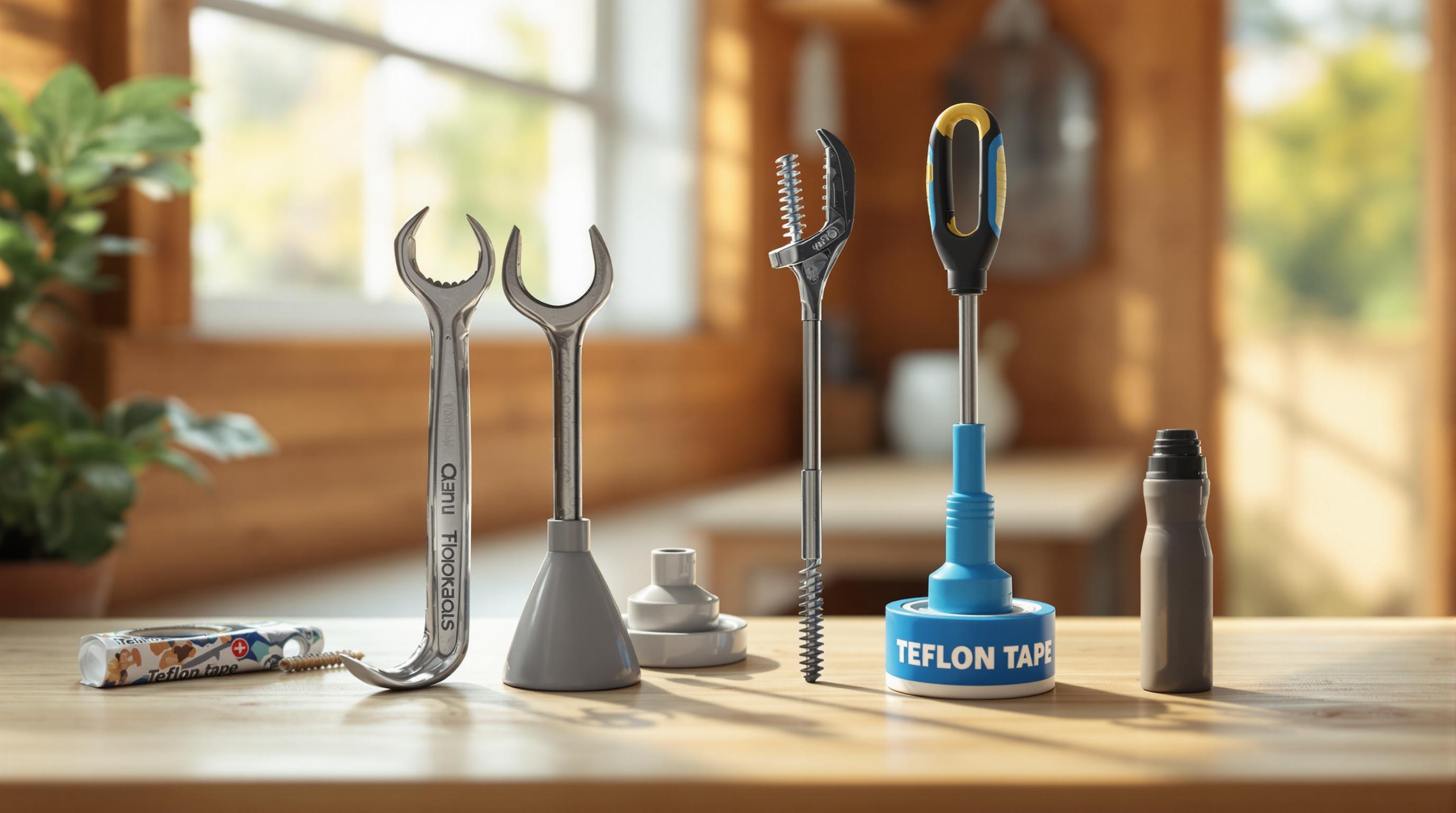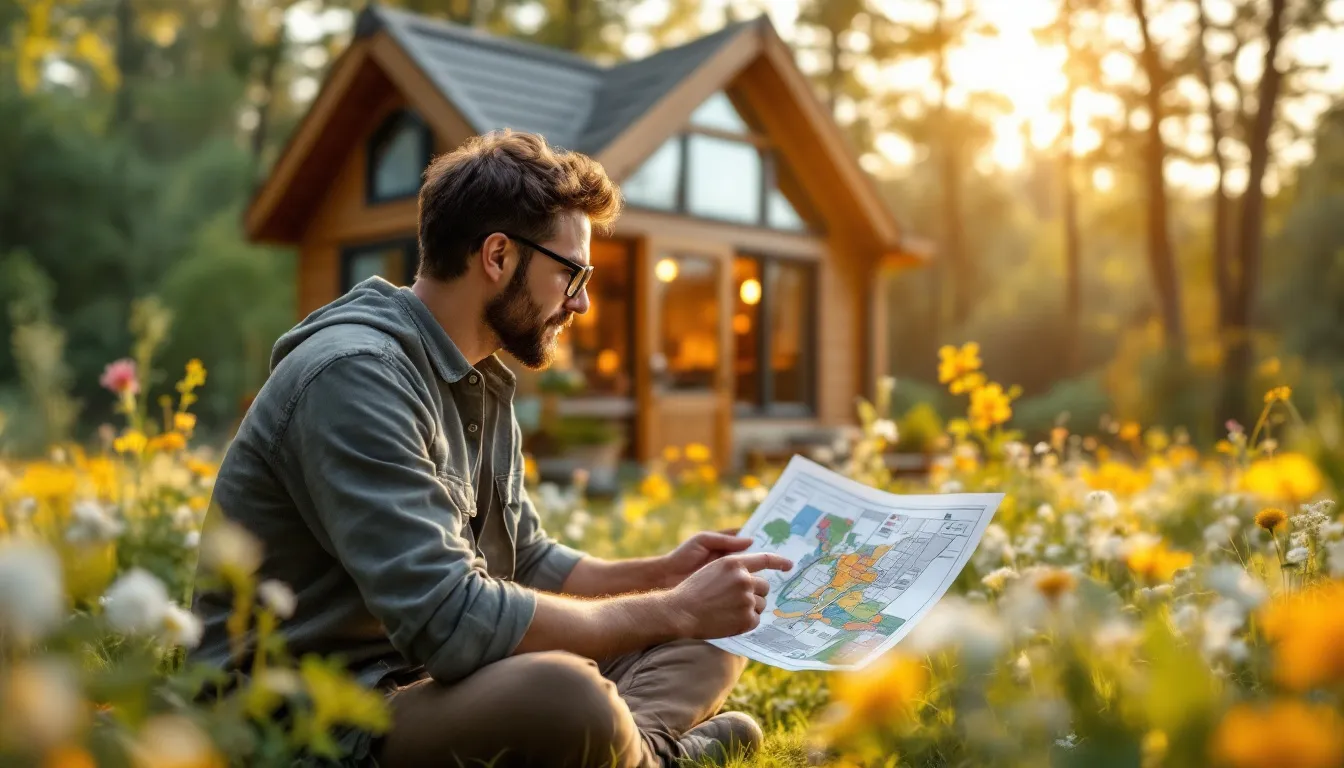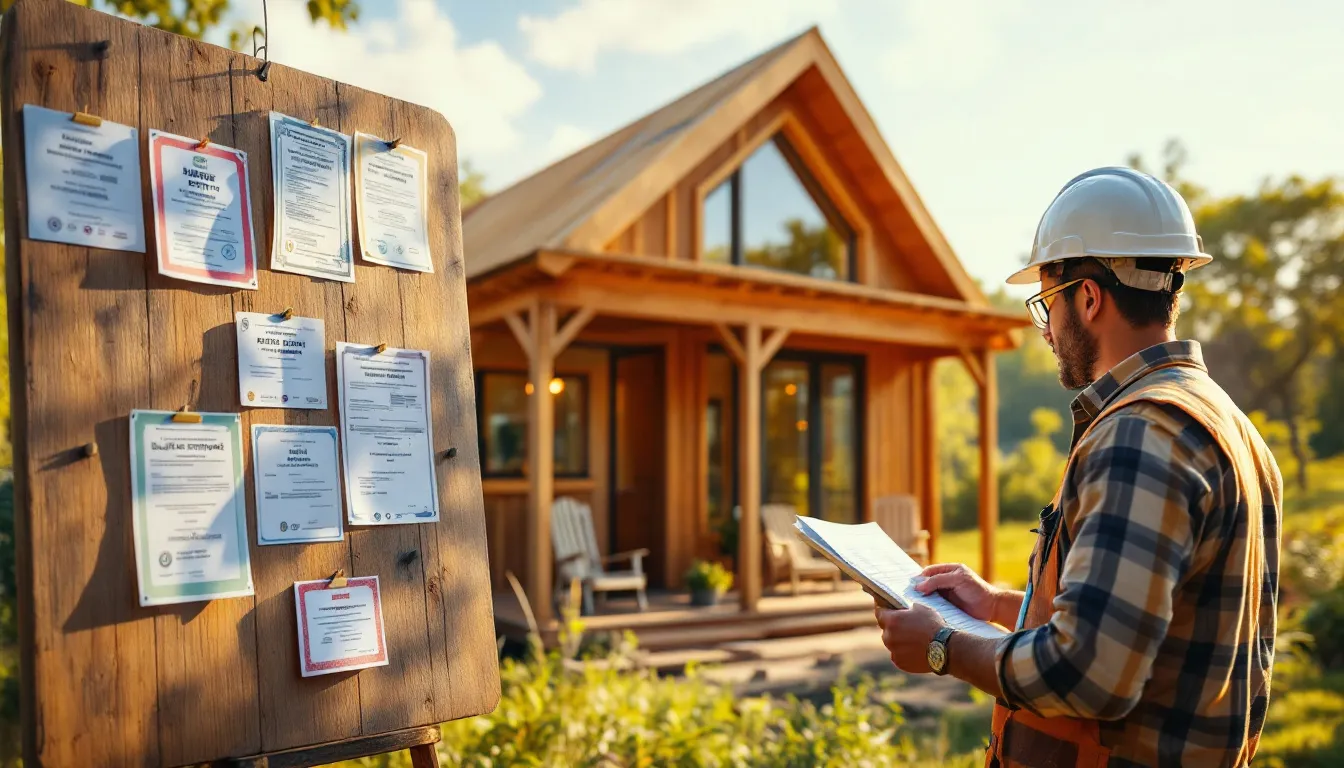A-frame tiny houses are gaining popularity for their unique triangular shape and smart design. Here's what you need to know:
- Cost: Typically $100,000 - $200,000 for a 1,000 sq ft A-frame
- Key features: Steep roof, large windows, open floor plan, loft space
- Ideal for: Minimalists, nature lovers, DIY enthusiasts, budget-conscious buyers
| Pros | Cons |
|---|---|
| Snow-shedding roof | Limited interior space |
| Energy efficient | Awkward corners |
| Simple to build | Tricky roof maintenance |
| Cozy feel | Less privacy |
| Weather-resistant | Less efficient in hot climates |
Building an A-frame involves:
- Planning and permits
- Setting the foundation
- Framing the structure
- Adding roof and insulation
- Installing systems and finishing interior
Living in an A-frame requires smart space use:
- Vertical storage solutions
- Multi-purpose furniture
- Loft optimization
- Off-grid potential
Regular maintenance is key to longevity. With proper care, an A-frame tiny house can be a cozy, efficient home that stands out from the crowd.
Related video from YouTube
A-Frame House Basics
A-frame tiny houses are more than just eye-catching triangles. These structures have been around since the 1930s, and they're packing a lot of punch in a small package.
Key Parts of an A-Frame
Think of an A-frame house as a wooden triangle sandwich. Here's what makes them special:
- The roof is steep and starts near the ground, meeting at the top to form the "A".
- Big windows (often floor-to-ceiling) flood the space with light and show off the views.
- The main floor is open, combining living, dining, and kitchen areas.
- A loft space sits under the roof's peak, perfect for sleeping or storage.
- The roof doubles as walls, cutting down on materials.
Good and Bad Points
A-frames, like any home, have their strengths and weaknesses:
| Pros | Cons |
|---|---|
| Roof sheds snow easily | Limited interior space |
| Efficient in cold climates | Awkward corners waste space |
| Simple to build (DIY potential) | Roof maintenance can be tricky |
| Cozy, cabin-like feel | Less privacy (open layout) |
| Tough in harsh weather | Less efficient in hot climates |
Making the Most of Space
A-frames might be small, but they're clever with space. Here's how to squeeze out every inch:
1. Use the Loft: Turn the upper level into a bedroom or reading nook.
2. Add Built-In Storage: Install shelves and cabinets on those sloped walls.
3. Choose Multi-Use Furniture: Go for Murphy beds, fold-down tables, and storage ottomans.
4. Expand Outdoors: Add a deck or patio for extra living space.
"With A-frames, think UP", says tiny house designer Sarah Johnson. "Those high ceilings are gold - use them for hanging storage or a cozy sleeping loft."
Planning Your Build
Let's get your A-frame tiny house project off the ground. Good planning is key to a smooth build.
Picking Your Land
Your A-frame's location can make or break your project. Here's what to look for:
- Can you get building materials to the site easily?
- Does the spot offer great views? A-frames are all about the scenery.
- How will local weather affect your house?
- Is it possible to connect water and electricity?
"Find a spot that's practical to build on but still makes you go 'wow' when you look out the window", advises tiny house designer Sarah Johnson.
Getting Legal Approval
Don't skip the paperwork. Here's the deal:
- Check if your area allows tiny houses.
- Make sure your design follows local building codes.
- Budget $1,000 to $2,000 for permits.
Heads up: Some places require at least one 120 square foot room in residential homes. Plan accordingly.
Cost Planning
Building an A-frame can be budget-friendly, but costs add up. Here's a rough breakdown:
| Item | Estimated Cost |
|---|---|
| Land | $5,000 - $18,000 per acre |
| Foundation | $3,000 - $8,000 |
| Materials | $10,000 - $30,000 |
| Labor (if not DIY) | 40% - 60% of total cost |
| Permits | $1,000 - $2,000 |
Add 10-20% to your total for unexpected costs. Better safe than sorry.
Choosing Materials
Your material choices matter. Here are some smart picks:
- Framing: Cedar wood fights moisture and bugs.
- Insulation: Fiberglass or spray foam keep energy bills low.
- Roofing: Metal sheets last long and shed snow well.
- Windows: Basic vinyl windows start around $200-$300 each.
Tools You'll Need
Going DIY? Here's your basic tool list:
- Circular saw
- Drill and drill bits
- Hammer
- Measuring tape
- Level
- Safety gear (goggles, gloves, hard hat)
For tricky jobs like roofing or wiring, think about renting tools or hiring pros.
Building Steps
Ready to build your A-frame tiny house? Let's get started! Here's your guide to turning that dream into reality.
Setting the Foundation
First things first: a rock-solid foundation.
1. Clear and level the ground
Get rid of plants and even out the surface.
2. Mark pier locations
Use batter boards and string lines. Pro tip: Pick one corner as your "home base" and measure everything else from there.
3. Dig and pour
Make 14" round, 24" deep holes for piers. Fill the bottom with small rocks, then use concrete form tubes.
"Pour concrete in two rounds to keep everything straight and level", says Sarah Johnson, tiny house designer. "It's extra work, but worth it."
Building the Frame
Now watch your A-frame take shape!
Start with the first triangle. Cut a 16-foot 2x6 board with 60-degree miter cuts on both ends for the floor joist.
Frame walls in sections. It's easier to lift and square them this way.
Install roof rafters. Stick to your design plans here.
Add bridging blocks to connect trusses and prevent sagging when you put on plywood.
Adding the Roof
Your A-frame's roof is its star feature. Make it count!
Put on house wrap. It's your first defense against water.
Add tar paper. Another key waterproofing step.
Install roofing material. Metal sheets are popular for A-frames. They last long and shed snow well.
Adding Insulation
Good insulation = comfy A-frame. Here's what to do:
Pick your insulation. Spray foam is often best because of its high R-value.
Install it between floor joists to control temperature.
Don't skip the vapor barrier. It protects your insulation from the inside and stops condensation and mold.
Installing Basic Systems
Time to make your A-frame livable!
| System | DIY-Friendly? | Pro Recommended? |
|---|---|---|
| Electrical | Some parts | Yes |
| Plumbing | Some parts | Yes |
| HVAC | No | Yes |
You can do some things yourself, but think about hiring pros for safety and to meet building codes, especially for complex systems.
Inside Work
The home stretch! Here's how to finish your A-frame interior:
Put up drywall and flooring. This turns your space from a work site into a home.
Add big appliances. Check that all electrical outlets and switches work right.
Maximize storage. In an A-frame, think UP. Use those sloped walls for shelves and cabinets.
"With A-frames, vertical space is gold", says Sarah Johnson. "Use high ceilings for hanging storage or a cozy sleeping loft."
Building an A-frame tiny house is fun and rewarding. It mixes simple design with smart use of space. Follow these steps and make the most of your A-frame's unique shape. You'll end up with a cozy, efficient home that stands out. Happy building!
sbb-itb-2ef3f3a
Making Life Work
Living in an A-frame tiny house? It's cozy, but you need to be smart about space. Here's how to make your triangular home work for you.
Smart Space Use
In an A-frame, every inch matters. Here's how to maximize your living area:
Go vertical. Tall, narrow shelves are your friends. They use those high ceilings to your advantage.
Multi-purpose furniture is key. Get a coffee table with hidden storage. It's not just a table - it's your secret storage weapon.
Fold-away solutions are game-changers. A wall-mounted desk that folds up when you're done? That's smart living.
Tim and Sam from Tiffany the Tiny Home say, "In our tiny home, everything has its place." They're all about DIY shelving and vertical stacking.
Storage Ideas
Creative storage keeps your A-frame tidy and functional. Here's where to stash your stuff:
| Location | Storage Solution |
|---|---|
| Under stairs | Drawers for clothes, gear |
| Kitchen | Pull-out spice racks, toe-kick drawers |
| Walls | Pegboards for open shelving |
| Floor | Hidden compartments |
Want a unique touch? Use vintage suitcases as storage. They're stylish and practical.
Using the Loft
Your A-frame loft? It's not just extra space - it's opportunity. Here's what you can do with it:
Make it your bedroom. A low-profile bed fits perfectly.
Turn it into a home office. A compact desk, and you're in business.
Create a reading nook. Add a skylight, and you've got a spot for books and stargazing.
One tiny home owner shares, "Adding a desk in our loft gave us a workspace without eating into our main living area."
Living Off-Grid
Many A-frame fans go off-grid. Here's how to make it happen:
1. Solar power
Use that south-facing roof slope. It's perfect for solar panels.
2. Water collection
Your steep roof isn't just for looks. It's great for catching rain.
3. Composting toilet
Save space and water. It's eco-friendly too.
4. Efficient appliances
Go for energy-star rated, compact versions. They're essential in a tiny home.
Living in an A-frame isn't just about the cool look. It's about smart choices that make your space work for you.
Keeping Your House in Good Shape
Living in an A-frame tiny house is cool, but it comes with its own maintenance challenges. Here's how to keep your triangular home in top shape all year.
What to Do Each Season
Seasonal maintenance is crucial. Here's what you need to do:
| Season | Tasks |
|---|---|
| Spring | Clean gutters, set up irrigation, power wash exterior |
| Summer | Reverse ceiling fans, check for mosquito spots, test A/C |
| Fall | Clean gutters again, disconnect hoses, check for drafts |
| Winter | Reverse fans back, drain outdoor faucets, inspect chimney |
Check your roof at least twice a year. Those steep angles are great for snow, but they can hide sneaky leaks.
"I thought roof inspections were for other people. Then I found a leak one rainy day. Lesson learned", says one tiny house owner.
Fixing Common Problems
A-frames have their quirks. Here's how to deal with them:
1. Leaky roof valleys
A-frames often leak where the slopes meet. Keep nails 10+ inches from valley centers and use roofing cement for small holes.
2. Drafty windows
Those big windows can let in cold air. Check and replace weatherstripping regularly to stay cozy.
3. Moisture buildup
The A-frame shape can trap moisture. Use a dehumidifier and ventilate well, especially in the bathroom and kitchen.
Making Your House Last
Want your A-frame to stick around? Try these:
- Re-stain your deck every 2-3 years and repaint the exterior every decade.
- In cold climates, insulate pipes to prevent freezing.
- Regularly check your A-frame's hidden spots. Use a small mirror to see under your tiny house.
"I found out about pipe insulation the hard way. A small leak behind my sink led to a mini flood", one owner warns.
Keep up with these tasks, and your A-frame tiny house will be your cozy triangle home for years to come.
Wrap-Up
Building and living in an A-frame tiny house? It's not just a project - it's an adventure. Let's break down this triangular journey and see how it can shake up your life.
Build Steps Review
Creating your A-frame home boils down to three main phases:
1. Planning and Preparation
This is where you get your ducks in a row. Figure out what you want, how much you can spend, and where you'll put your new home. Oh, and don't forget those pesky permits!
2. Construction
Time to get your hands dirty. Start with a solid foundation, then watch as that iconic A-shape takes form. Top it off with a roof, insulation, and weatherproofing to keep Mother Nature at bay.
3. Finishing Touches
Now for the fun part. Hook up your utilities, make the inside look pretty, and get creative with storage. Trust me, you'll need every inch!
"Here's a reality check: that house kit price? It's just the tip of the iceberg. Double it to get close to your real budget. And don't forget about buying land!" - Sarah Johnson, tiny house guru
Living Small in an A-Frame
Choosing an A-frame isn't just about having a cool-looking house. It's a whole new way of life:
| What You Get | What It Means |
|---|---|
| Smaller Bills | Less space = less money out of your pocket |
| Less Stuff | No room for junk = more intentional living |
| Nature Connection | Big windows = bringing the outdoors in |
| Eco-Friendly | Smaller home = smaller footprint on the planet |
The Fishbeyns, who live in a 300-square-foot A-frame, say it best: "Our tiny house? It doesn't feel tiny at all. We've got everything we need, plus a front-row seat to nature."
And get this: Joshua and Shelley Engberg turned their 374-square-foot A-frame into a party pad. How? With a massive 8-foot window that opens up. Instant indoor-outdoor living!
Living in an A-frame isn't about what you own. It's about what you experience. Ready to trade stuff for stories?
FAQs
Can you build A-frame house yourself?
Yes, you can build an A-frame house yourself. But it's not a walk in the park.
Here's the deal:
Using a construction kit makes it easier. But you'll still need good DIY skills, time, and commitment.
Andrew Szeto, a woodworker who built his own A-frame in Quebec, says:
"Looking on the internet, there wasn't a ton on actually building an A-Frame (without buying a prefab from Matti or something), so as a natural continuation of the woodworking I've been doing the past few years I set out to build a cabin in Low, Quebec, about an hour from where I live."
Thinking about going DIY? Here's what you need to know:
Do your homework. Read everything you can about self-building before you start.
Get expert advice. Talk to experienced builders. They'll help you avoid missing crucial details.
Consider a kit. Two people can usually put together a small A-frame home kit without extra help.
Be realistic. Larger kits might need more hands, but you can still do it yourself.
One expert puts it bluntly: "Without doing proper homework and without involving the right people for help, you are setting yourself up for failure."
Bottom line: Building your own A-frame can be awesome. But you need the right skills, mindset, and resources. It's not for everyone, but if you're up for the challenge, it can be incredibly rewarding.



